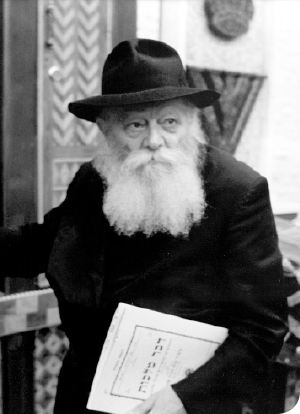The Rebbe ruled about how to approach all the Rosh HaShanas of all years to come until the coming of Moshiach – that the kabbalas ol must be amidst plenty. * Chapter 7 of Rabbi Shloma Majeski’s Likkutei Mekoros continues, discussing how the Rebbe taught us in advance how to view the events of Gimmel Tammuz 5754. (Underlined text is the compiler’s emphasis.)
Translated by Boruch Merkur
 The Rebbe Rayatz’s discussion of eternal life on 13 Tammuz 5709, referenced above:
The Rebbe Rayatz’s discussion of eternal life on 13 Tammuz 5709, referenced above:
The Alter Rebbe received the tradition from his master, the Mezritcher Maggid, who had received as a tradition from his master, our teacher, the Baal Shem Tov, of asking others, “What do you remember?” [encouraging them to recall and learn from all they were taught or had experienced throughout their life].
This saying, “What do you remember?” enlivened the Chassidim of that generation with the vitality of T’chiyas HaMeisim, the Resurrection of the Dead. T’chiyas HaMeisim is described as being “chayim aruchim – long life,” true life. Death is an interruption, whereas “chayim aruchim” is life free of interruption, which is true life. No absence of life; it is only life. In terms of avoda, the service of G-d, it is not only the fact that one lives but that he enlivens others as well.
The point here is that true life is holiness and holiness is ein sof (endless, eternal).
(Seifer HaMaamarim 5710, pg. 262)
***
From the talk of 5709, published in Kuntres Yud-Beis Tammuz 5710, one can draw life and inspiration, and strengthen his present service of G-d in his current place. That sicha contains proof that even the mortal intellect can understand that there is no room for one to think that he is isolated and abandoned, G-d forbid, and that certainly there is no grounds for weakness in avoda. If only members of anash, especially the T’mimim, were exact and precise with the words of my revered father in-law, the Rebbe, הכ”מ, including his sichos, and particularly those from the year 5710 and the preceding year.
(Igros Kodesh of 5711, #5785, pg. 24)
***
2. In the maamarim of my revered father in-law, the Rebbe, there are many wondrous things. Aside from the profound intellect and depth they contain, there are also wondrous and incredible statements [bordering on prophecy] to be found in them. This is especially the case with regard to the maamarim of just before the histalkus. Oddly, no one has noted this fact or pointed it out. However, when we delve into these maamarim, with a “penetrating gaze,” as the Rebbe would say, we notice several incredible things. This is not only to be found in the Hemshech Basi L’Gani [written to be distributed for the day that the Rebbe Rayatz was nistalek], where many fantastic things are alluded to (e.g., the Rebbe mentions the notion that a person does not know his time [to pass on from this world]), but even the maamarim throughout the entire year of 5710, beginning with Rosh HaShana, contain many prophetic statements.
In that Rosh HaShana maamer, immediately in the first section, there is something wondrous, which until now I had not found precedent for anywhere in Chassidus, although after considering it, it is clearly an explicit saying of our Sages. Nevertheless, I had not found a precedent for such talk in Chassidus, except in the maamer of Rosh HaShana 5710.
We always speak about Rosh HaShana as characterized by the verse, “from the straits I cried out.” And the greater the “outcry,” the greater the “answer me va’merchav (expansively, amidst plenty)” [as the verse continues]. True, it says that a year that begins with poverty ends in affluence, but this does not mean that we must wait an entire year for affluence. Rather, one is blessed with wealth immediately following the poverty. So long as there is the resolution to accept the yoke of heaven, right away after committing to kabbalas ol comes wealth. Typically kabbalas ol itself is in a manner of “from the straits.” However, the maamer says that the kabbalas ol of Rosh HaShana must be amidst plenty.
As stated above, the maamer of Rosh HaShana 5710, the year of the histalkus, is [prophetic] in the sense that the Gemara tells of how Hillel made an assessment and an account of all the years to come. The same applies to the maamer of Rosh HaShana 5710. There the Rebbe ruled about how to approach all the Rosh HaShanas of all years to come until the coming of Moshiach – that the kabbalas ol must be amidst plenty.
It is not that the Rebbe said this parenthetically. It is, rather, a central matter, for which reason it is mentioned in the summary of the maamer. As has been stated before, the summaries only include the central concepts; not topics that are tangential.
One might interpret this expansiveness, this plenty, as it applies only to spiritual matters. Thus it is explicitly interpreted to also mean expansive in the material sense. One may interpret this to mean that it is only a concept that is applicable to the inner dimension of the Torah and has no connection to the world. Thus the Rebbe brings proof from a Midrash, the revealed dimension of the Torah, in order to draw it down into the world. It is reminiscent of what is explained in the maamer “B’Chochma Yibaneh Bais” of the Alter Rebbe – the reason for bringing proofs from verses in the Torah is in order to connect it with the world, that it should be unwavering [and manifest within the world].
(From the address of Shabbos Parshas Haazinu, Shabbos T’shuva, 5724; Sichos Kodesh 5724, pg. 2-3)